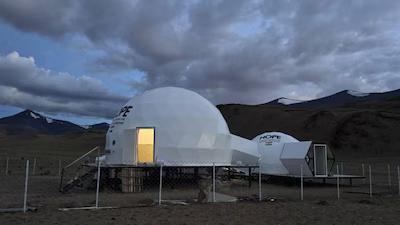
ISRO Sets Up Station in Ladakh to Simulate Life on Moon & Mars
In a significant move towards advancing India’s space exploration capabilities, the Indian Space Research Organisation (ISRO) has established a unique station in Ladakh’s Tso Kar Valley, known as the Himalayan Outpost for Planetary Exploration (HOPE). The station is designed to simulate life on both the Moon and Mars, with the ultimate goal of preparing for future human missions to these celestial bodies.
Located in the Tso Kar Valley, which is situated at an altitude of over 15,000 feet, the HOPE station is an ideal location to test life-support systems for lunar and Martian missions. The valley’s extreme environment, characterized by high UV radiation, low atmospheric pressure, extreme cold, and saline permafrost, is remarkably similar to that of Mars. This makes it an ideal location to simulate the harsh conditions that astronauts will face on future missions to the Red Planet.
The HOPE station is a 10-day simulation mission, which will commence on August 1 and conclude on August 10. Two crew members will undertake various tests at the facility, which will include monitoring the effects of high altitude and extreme cold on the human body. The crew will also test the life-support systems, including air, water, and food supply, as well as communication equipment.
According to ISRO officials, the HOPE station is an essential step towards preparing for future human missions to the Moon and Mars. “The HOPE station is a unique facility that will enable us to test the life-support systems for our future missions to the Moon and Mars,” said an ISRO official. “The Tso Kar Valley provides an ideal environment to simulate the harsh conditions that astronauts will face on these missions, and we are confident that the data collected during this simulation mission will be invaluable in planning our future missions.”
The HOPE station is equipped with state-of-the-art facilities, including a mock-up of the lunar and Martian surface, which will enable the crew to simulate the conditions they will face on these celestial bodies. The station also has advanced life-support systems, including air, water, and food supply, as well as communication equipment to maintain contact with the outside world.
The Tso Kar Valley was chosen as the location for the HOPE station due to its unique environmental conditions, which are reminiscent of those found on Mars. The valley’s high altitude, low atmospheric pressure, and extreme cold provide an ideal environment to simulate the harsh conditions that astronauts will face on future missions to Mars.
The HOPE station is not just a test facility, but also a scientific research station that will enable scientists to study the effects of high altitude and extreme cold on the human body. The data collected during the simulation mission will be used to develop strategies for protecting the health and well-being of astronauts on future missions to the Moon and Mars.
In conclusion, the HOPE station is an important step forward in India’s space exploration capabilities, and marks a significant milestone in the country’s efforts to send humans to the Moon and Mars. The simulation mission will provide valuable data and insights that will be used to plan and execute future missions, and will ultimately enable India to take a major leap forward in the field of space exploration.






